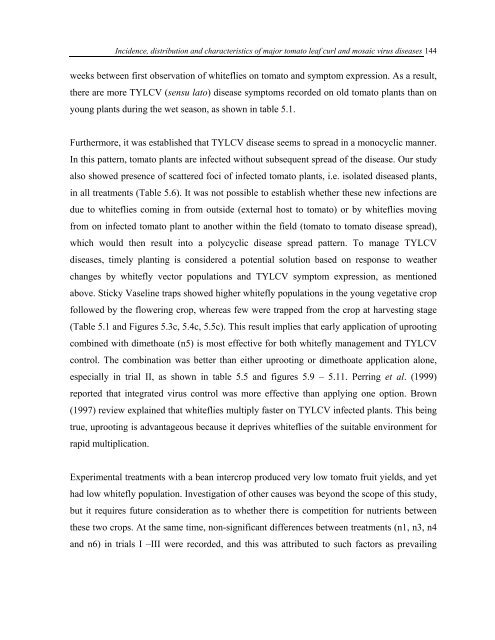Incidence, Distribution and Characteristics of Major Tomato Leaf ...
Incidence, Distribution and Characteristics of Major Tomato Leaf ...
Incidence, Distribution and Characteristics of Major Tomato Leaf ...
Create successful ePaper yourself
Turn your PDF publications into a flip-book with our unique Google optimized e-Paper software.
<strong>Incidence</strong>, distribution <strong>and</strong> characteristics <strong>of</strong> major tomato leaf curl <strong>and</strong> mosaic virus diseases 144<br />
weeks between first observation <strong>of</strong> whiteflies on tomato <strong>and</strong> symptom expression. As a result,<br />
there are more TYLCV (sensu lato) disease symptoms recorded on old tomato plants than on<br />
young plants during the wet season, as shown in table 5.1.<br />
Furthermore, it was established that TYLCV disease seems to spread in a monocyclic manner.<br />
In this pattern, tomato plants are infected without subsequent spread <strong>of</strong> the disease. Our study<br />
also showed presence <strong>of</strong> scattered foci <strong>of</strong> infected tomato plants, i.e. isolated diseased plants,<br />
in all treatments (Table 5.6). It was not possible to establish whether these new infections are<br />
due to whiteflies coming in from outside (external host to tomato) or by whiteflies moving<br />
from on infected tomato plant to another within the field (tomato to tomato disease spread),<br />
which would then result into a polycyclic disease spread pattern. To manage TYLCV<br />
diseases, timely planting is considered a potential solution based on response to weather<br />
changes by whitefly vector populations <strong>and</strong> TYLCV symptom expression, as mentioned<br />
above. Sticky Vaseline traps showed higher whitefly populations in the young vegetative crop<br />
followed by the flowering crop, whereas few were trapped from the crop at harvesting stage<br />
(Table 5.1 <strong>and</strong> Figures 5.3c, 5.4c, 5.5c). This result implies that early application <strong>of</strong> uprooting<br />
combined with dimethoate (n5) is most effective for both whitefly management <strong>and</strong> TYLCV<br />
control. The combination was better than either uprooting or dimethoate application alone,<br />
especially in trial II, as shown in table 5.5 <strong>and</strong> figures 5.9 – 5.11. Perring et al. (1999)<br />
reported that integrated virus control was more effective than applying one option. Brown<br />
(1997) review explained that whiteflies multiply faster on TYLCV infected plants. This being<br />
true, uprooting is advantageous because it deprives whiteflies <strong>of</strong> the suitable environment for<br />
rapid multiplication.<br />
Experimental treatments with a bean intercrop produced very low tomato fruit yields, <strong>and</strong> yet<br />
had low whitefly population. Investigation <strong>of</strong> other causes was beyond the scope <strong>of</strong> this study,<br />
but it requires future consideration as to whether there is competition for nutrients between<br />
these two crops. At the same time, non-significant differences between treatments (n1, n3, n4<br />
<strong>and</strong> n6) in trials I –III were recorded, <strong>and</strong> this was attributed to such factors as prevailing





